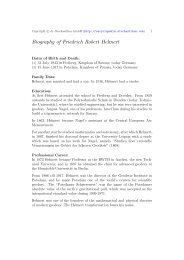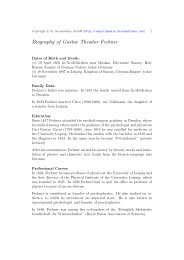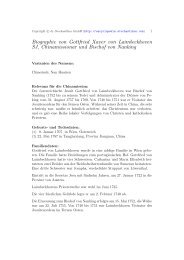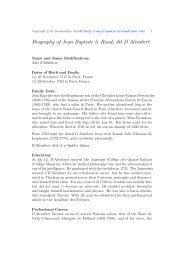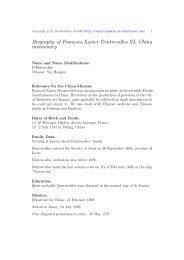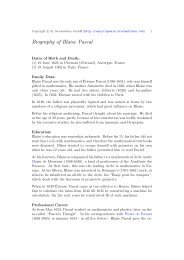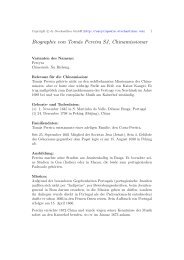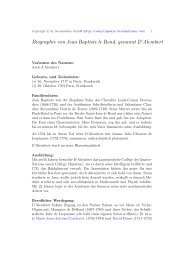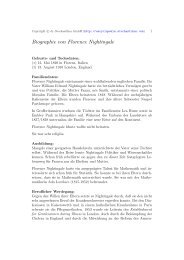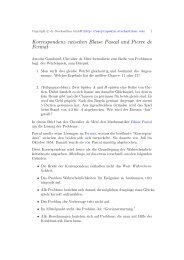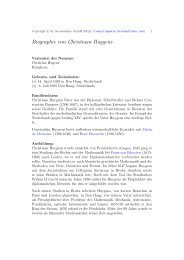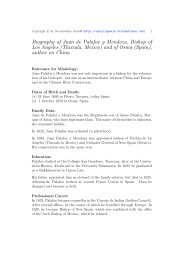Biography of Michele Ruggieri SJ, China missionary
Biography of Michele Ruggieri SJ, China missionary
Biography of Michele Ruggieri SJ, China missionary
You also want an ePaper? Increase the reach of your titles
YUMPU automatically turns print PDFs into web optimized ePapers that Google loves.
Copyright c○ by Stochastikon GmbH (http://encyclopedia.stochastikon.com) 1<br />
<strong>Biography</strong> <strong>of</strong> <strong>Michele</strong> <strong>Ruggieri</strong> <strong>SJ</strong>, <strong>China</strong> <strong>missionary</strong><br />
Name and Name Modifications:<br />
Originally: Pompilio<br />
Chinese: Luo Mingjian<br />
Relevance for the <strong>China</strong> Mission:<br />
Together with Matteo Ricci (1552-1610), <strong>Michele</strong> <strong>Ruggieri</strong> belongs to the pioneers<br />
<strong>of</strong> the <strong>China</strong> mission <strong>of</strong> early modern times. He was the first European<br />
to study the Chinese language in Macau, he made important contributions<br />
to the Method <strong>of</strong> Accommodation in <strong>China</strong>, and he started to translate the<br />
Four Confucian Books.<br />
Dates <strong>of</strong> Birth and Death:<br />
(∗) 1543 in Spinazzola, Apulia, Kingdom <strong>of</strong> Naples, today Italy<br />
(†) 11 May 1607 in Salerno, Campagna, Kingdom <strong>of</strong> Sicily, today Italy<br />
Family Data:<br />
<strong>Ruggieri</strong>’s parents were Lodovico and Giulia Fonella. They called their son<br />
Pompilio. The father was in the administration <strong>of</strong> Spinazzola.<br />
<strong>Ruggieri</strong> joined the Society <strong>of</strong> Jesus in Rome on 27 or 28 October 1572.<br />
His ordination to priesthood was on 12 March 1578 in Lisbon.<br />
It is unknown when and where <strong>Ruggieri</strong> made his four solemn vows.<br />
Education:<br />
<strong>Ruggieri</strong> received his first education in Naples at the school <strong>of</strong> the Jesuits.<br />
In 1560, <strong>Ruggieri</strong> enrolled for the study <strong>of</strong> both laws (canon and secular) at<br />
the University <strong>of</strong> Naples, where he obtained the doctoral degree. Afterwards,<br />
he worked to the Court <strong>of</strong> Justice.<br />
Mission:<br />
Departure for <strong>China</strong>: in 1578.
Copyright c○ by Stochastikon GmbH (http://encyclopedia.stochastikon.com) 2<br />
Arrival in <strong>China</strong>: on 20 July 1579, in the Portuguese Enclave Macau.<br />
Pr<strong>of</strong>essional Career:<br />
In Macau, <strong>Ruggieri</strong> had first contacts with the Jesuits Visitor Alessandro<br />
Valignano (1539-1606), who gave the outlines <strong>of</strong> the mission method <strong>of</strong> accommodation.<br />
This method should help to get contact to the Chinese people<br />
and, perhaps, to start to do <strong>missionary</strong> work. Against the resistance <strong>of</strong> his<br />
brethren in Macau, <strong>Ruggieri</strong> started to study the Chinese language, which<br />
was considered to be impossible to be understood by Europeans. Nevertheless,<br />
he succeeded to learn it so that he could join the annual Portuguese<br />
trade legation to Guangdong as an interpreter. <strong>Ruggieri</strong> was highly admired<br />
by the Chinese because <strong>of</strong> his abilities in the Chinese language and his politeness,<br />
but only obtained a limited permission to stay in <strong>China</strong>. He celebrated<br />
the first Eucharist on Chinese soil, and together with Fr. António de Almeida<br />
(1557-1591), <strong>Ruggieri</strong> founded a mission in Zhejiang (1585), in Guangxi and<br />
in Huguang (1587), but he was not permitted to stay there. In November<br />
1588, he was ordered to return to Rome to prepare a Papal delegation to the<br />
Imperial Court in Peking.<br />
Based on <strong>Ruggieri</strong>’s experiences and preparatory work, his confrere Matteo<br />
Ricci (in Macau since 1582, in <strong>China</strong> since 1583) succeeded to found the<br />
<strong>China</strong> mission <strong>of</strong> early modern times for a long-term. Contrary to Ricci<br />
and to most <strong>of</strong> his later brethren, <strong>Ruggieri</strong> refused Confucianism and tried<br />
to cooperate with Buddhism. <strong>Ruggieri</strong> wrote the first Chinese catechism <strong>of</strong><br />
modern times and translated as first European part <strong>of</strong> the Chinese Classical<br />
books, which remained unpublished. But they became the fundament <strong>of</strong> later<br />
translations and publications <strong>of</strong> the Confucian Classics made by the Jesuits<br />
in <strong>China</strong>.<br />
Publications <strong>Michele</strong> <strong>Ruggieri</strong>:<br />
• “Itinerandum Sinice factum” (ca. 1580-1590), English in: Albert Chan,<br />
“<strong>Michele</strong> <strong>Ruggieri</strong>, S.J. (1543-1607) and His Chinese Poems”, Monumenta<br />
Serica 41 (1993) pp. 139-157.<br />
• Together with Matteo Ricci et al.: Zu chuan tian zhu shi jie (1583).<br />
• <strong>Ruggieri</strong>’s catechism: Xin bian Xizhu guo tian zhu shi lu (1584), also<br />
as: Tianzhu shilu, Latin: “Vera ac brevis divinarum rerum expositio”,<br />
(1582), Latin in: Antonio Possevino, Bibliotheca selecta qua agitur<br />
de ratione studiorum in historia, in disciplinis, in salute omnium
Copyright c○ by Stochastikon GmbH (http://encyclopedia.stochastikon.com) 3<br />
procuranda (Romae 1593), t. I, liber IX, cap. XXVIII, p. 456, cf.<br />
Piero Tacchi Venturi, Opere storiche del P. Matteo Ricci S.J., vol. 2<br />
(Roma 1911-1913) pp. 498-540, later revised: Tianzhu sheng jiao shi<br />
lu (posthumously, ca. 1640), s.a Nicolas Standaert, Ad Dudink (eds.),<br />
Yesu hui Luoma dang an guan Ming Qing tian zhu jiao wen xian (Chinese<br />
Christian texts from the Roman Archives <strong>of</strong> the Society <strong>of</strong> Jesus),<br />
12 vols. (Taibei 2002), vol. 1, # 1.<br />
• Jiao yao (1584).<br />
• Together with Anonym: Luoma jiao huang zhi Da Ming guo guo zhu<br />
shu (Letter by Pope Sixtus V [1585-1590] to the emperor <strong>of</strong> <strong>China</strong>)<br />
(1590).<br />
• “Lettera del P. <strong>Michele</strong> <strong>Ruggieri</strong> S.J. al P. Everardo Mercuriano, Preposito<br />
Generale, Macao, 8 Novembre 1580, in: Pietro Tacchi Venturi (ed.),<br />
Opere storiche del P. M. Ricci, vol. II: Lettere dalla Cina (Macerata<br />
1913) pp. 396-399.<br />
• “Lettera del P. <strong>Michele</strong> <strong>Ruggieri</strong> S.J. al P. Everardo mercuriano, Preposito<br />
Generale, Macao, 12 Novembre 1581”, in: Pietro Tacchi Venturi<br />
(ed.), Opere storiche del P. M. Ricci, vol. II: Lettere dalla Cina (Macerata<br />
1913) pp. 399-406.<br />
• “Lettera del P. <strong>Michele</strong> <strong>Ruggieri</strong> S.J. al P. Claudio Acquaviva, Preposito<br />
Generale, Macao, 14 Dicembre 1582”, in: Pietro Tacchi Venturi<br />
(ed.), Opere storiche del P. M. Ricci, vol. II: Lettere dalla Cina (Macerata<br />
1913) pp. 402-408.<br />
• “Lettera del P. <strong>Michele</strong> <strong>Ruggieri</strong> S.J. al P. Claudio Aquaviva, Preposito<br />
Generale, Sciaochin, 7 Febbraio 1583”, in: Avvisi della Cina dell’ottantatre,<br />
et dell’ottantaquvattro (Venezia 1586) pp. 169-174, Pietro Tacchi<br />
Venturi (ed.), Opere storiche del P. M. Ricci, vol. II: Lettere dalla Cina<br />
(Macerata 1913) pp. 410-419, Fernere Zeitung (Dilingen 1586) pp. 150-<br />
155, englisch in: M. Howard Rienstra (ed., transl.), Jesuit Letters from<br />
<strong>China</strong> 1583-84 (Minneapolis 1986) pp. 15-19.<br />
• “Carta del P. Miguel Rogerio S.J. al Padre Alonso Sánchez, Xauquin,<br />
a 7 de Hebrero de 1583”, in: Francisco Colín, Pablo Pastells, Labor<br />
evangélica de los obreros de la Compañia de Jesús en las Islas Filipinas,<br />
vol. 1 (Barcelona 1904) p. 315.<br />
• “Carta de los PP. Miguel Rogerio y Francisco Pasio al P. Pero Gómez,<br />
rector del colegio de Macan, Xauqín, a 10 de Hebrero de 1583, in:
Copyright c○ by Stochastikon GmbH (http://encyclopedia.stochastikon.com) 4<br />
Francisco Colín, Pablo Pastells, Labor evangélica de los obreros de la<br />
Compañia de Jesús en las Islas Filipinas, vol. 1 (Barcelona 1904) p.<br />
318.<br />
• “Carta de los PP. Miguel Rogerio y Francisco Pasio al P. Pero Gómez,<br />
Xauquín, a 12 de Hebrero de 1583”, in: Francisco Colín, Pablo Pastells,<br />
Labor evangélica de los obreros de la Compañia de Jesús en las Islas<br />
Filipinas, vol. 1 (Barcelona 1904) p. 319.<br />
• “Lettera del P. <strong>Michele</strong> <strong>Ruggieri</strong> S.J. al P. Claudio Acquaviva, Preposito<br />
Generale, Macao, 25 Gennaio 1584”, in: Avvisi della Cina dell’ottantatre,<br />
et dell’ottantaquvattro (Venezia 1586) pp. 177-179, Luís Froís, Fernere<br />
Zeitung auß Japon, deß zwey unnd achtzigsten, und vier und achtzigsten<br />
Jahr (Dillingen 1586) pp. 157-158, englisch in: M. Howard Rienstra<br />
(ed., transl.), Jesuit Letters from <strong>China</strong> 1583-84 (Minneapolis 1986)<br />
pp. 1f, Pietro Tacchi Venturi (ed.), Opere storiche del P. M. Ricci, vol.<br />
II: Lettere dalla Cina (Macerata 1913) pp. 419-421.<br />
• “Lettera del P. <strong>Michele</strong> <strong>Ruggieri</strong> S.J. al P. Claudio Acquaviva, Sciaochin,<br />
30 Maggio 1584”, in: Avvisi della Cina dell’ottantatre, et dell’ottantaquvattro<br />
(Venezia 1586) pp. 179f, Pietro Tacchi Venturi (ed.), Opere storiche del<br />
P. M. Ricci, vol. II: Lettere dalla Cina (Macerata 1913) pp. 422-424,<br />
Luís Froís, Fernere Zeitung auß Japon, deß zwey unnd achtzigsten, und<br />
vier und achtzigsten Jahr (Dillingen 1586) pp. 158f.<br />
• “Da un’altra [lettera] del P. <strong>Michele</strong> Ruggiero, di Amacano, 21 di Ottobre<br />
1584”, in: Avvisi della Cina dell’ottantatre, et dell’ottantaquvattro<br />
(Venezia 1586) pp. 180f, Luís Froís, Fernere Zeitung auß Japon, deß<br />
zwey unnd achtzigsten, und vier und achtzigsten Jahr (Dillingen 1586)<br />
pp. 159f, englisch in: M. Howard Rienstra (ed., transl.), Jesuit Letters<br />
from <strong>China</strong> 1583-84 (Minneapolis 1986) pp. 23f.<br />
• “Lettera del P. <strong>Michele</strong> <strong>Ruggieri</strong> S.J. al P. Claudio Acquaviva, Sicaochin,<br />
18 Ottobre 1585”, in: Pietro Tacchi Venturi (ed.), Opere storiche del<br />
P. M. Ricci, vol. II: Lettere dalla Cina (Macerata 1913) pp. 434f.<br />
• Translation <strong>of</strong> several lines <strong>of</strong> the Confucian Classic Da Xue (Die große<br />
Lehre) in: Antonio Possevino, Bibliotheca Selecta quae agitur de Ratione<br />
Studiorum t. I (Rome 1593) lib. IX, p. 583.<br />
• Eugenio Lo Sardo (ed.), Atlante della Cina di <strong>Michele</strong> <strong>Ruggieri</strong>, S.I.<br />
(Roma 1993).
Copyright c○ by Stochastikon GmbH (http://encyclopedia.stochastikon.com) 5<br />
• M. Howard Rienstra, Jesuit Letters from <strong>China</strong> 1583-84 (Minneapolis<br />
1986) (Pasio, <strong>Ruggieri</strong>, Cabral).<br />
• “On the birthday <strong>of</strong> God (twelve poems)”, in: Roman Malek (ed.),<br />
The Chinese face <strong>of</strong> Jesus Christ, vol. 2 (Sankt Augustin 2003) pp.<br />
750-751.<br />
• “Early Jesuits on Jesus Christ”, in: Roman Malek (ed.), The Chinese<br />
face <strong>of</strong> Jesus Christ, vol. 2 (Sankt Augustin 2003) pp. 745-749.<br />
• John W. Witek (ed.), Dicionário Português-Chinês= Pu Han ci dian=Portuguese-Chinese<br />
dictionary (Lisboa 2001) (together with Matteo Ricci).<br />
<strong>Michele</strong> <strong>Ruggieri</strong> Bibliography:<br />
• Marina Battaglini, “The Jesuit Manuscripts Concerning <strong>China</strong>, Preserved<br />
in the Biblioteca Nazionale centrale - Vittorio Emanuele II in Rome”, in:<br />
Actes du Ve Colloque international de Sinologie, Chantilly 1986 (Taipei -<br />
Paris 1993) pp. 35-75.<br />
• Marina Battaglini, “The Jesuit manuscripts on <strong>China</strong> preserved in the Biblioteca<br />
Nazionale in Rome”, in: Federico Masini (ed.), Western Humanistic<br />
Culture presented to <strong>China</strong> by Jesuit Missionaries (XVII-XVIII centuries)<br />
(Bibliotheca Instituti Historici S.I. vol. XLIX) (Roma 1996) pp. 11-100.<br />
• Henri Bernard, “Les adaptations chinoises des ouvrages européens”, Monumenta<br />
Serica X (1945) pp. 1-57; pp. 309-388; Monumenta Serica XIX (1960)<br />
pp. 349-383.<br />
• Henri Cordier, L’imprimerie sino-européenne en Chine (Paris 1901).<br />
• Joseph Dehergne, Répertoire des Jésuites de Chine de 1552 à 1800 (Rome,<br />
Paris 1973) pp. 235f.<br />
• Paul Pelliot, Inventaire sommaire des manuscrits et imprimé chinoise de<br />
la Bibliothèque Vaticane, Takata Tokio (ed.) (Italian School <strong>of</strong> East Asian<br />
Studies Reference Series 1) (Kyoto 1995).<br />
• Louis Pfister, Notices biographiques et bibliographiques sur les Jésuites de<br />
l’ancienne Mission de Chine 1552-1773 1932, pp. 15-21.<br />
• Robert Streit (ed.), Bibliotheca Missionum, vol. IV (Freiburg 1928) pp.<br />
521f.<br />
• Yu Dong, Catalogo delle opere cinesi missionarie della Biblioteca Apoatolica<br />
Vaticana (XVI-XVIII sec.) (Città del Vaticano 1996).<br />
• Henri Bernard, Aux portes de la Chine. Les Missionnaires du XVIo siècle<br />
(1514-1588) (Tientsin 1933).<br />
• Albert Chan, “<strong>Michele</strong> <strong>Ruggieri</strong>, S.J. (1543-1607) and His Chinese Poems”,
Copyright c○ by Stochastikon GmbH (http://encyclopedia.stochastikon.com) 6<br />
Monumenta Serica 41 (1993) pp. 129-176.<br />
• Albert Chan, “Two Chinese Poems Written by Hsü Wei (1521-1593) on<br />
<strong>Michele</strong> <strong>Ruggieri</strong>, S.J. (1543-1607)”, Monumenta Serica 44 (1996) pp. 317-<br />
337.<br />
• Claudia von Collani, “Die <strong>China</strong>mission von 1520-1630”, in: Die Geschichte<br />
des Christentums, Band 8: Die Zeit der Konfessionen (1530-1620/30) (Freiburg<br />
1992) pp. 933-942.<br />
• Gianni Criveller, Preaching Christ in Late Ming <strong>China</strong>. The Jesuit presentation<br />
<strong>of</strong> Christ from Matteo Ricci to Giulio Aleni (Taipei 1997).<br />
• Pasquale d’Elia, “Quadro storico sinologico del primo libro di dottrina cristiana<br />
in cinese”, Archivum Historicum Societatis Jesu 3 (1932) pp. 193-222.<br />
• George H. Dunne, Generation <strong>of</strong> Giants. The First Jesuits in <strong>China</strong> (Notre<br />
Dame 1962), German: Das große Exempel (Stuttgart 1965).<br />
• Francesco Antonio Gisondi, <strong>Michele</strong> <strong>Ruggieri</strong> S.J.: missionario in Cina,<br />
primo sinologo europeo e poeta “cinese”. (Spinazzola 1543 - Salerno 1607)<br />
(Milano 1999).<br />
• L.C. Goodrich, Dictionary <strong>of</strong> Ming <strong>Biography</strong> 1368-1644, (New York 1976)<br />
cols. 1148-1149.<br />
• Eugenio Lo Sardo, “L’Atlante della Cina di M.R. (XVIsec.)”, in: La cartografia<br />
geografica nel progresso delle conescenze sull’Oriente nell’Europa dei<br />
secoli XV-XIX (1991) pp. 127-141.<br />
• Eugenio Lo Sardo, Atlante della Cina di <strong>Michele</strong> <strong>Ruggieri</strong> S.J. (Roma<br />
1993).<br />
• Eugenio Lo Sardo, “The Earliest European Atlas <strong>of</strong> Ming <strong>China</strong>s: An Unpublished<br />
Work by <strong>Michele</strong> <strong>Ruggieri</strong>”, in: Actes du Colloque international<br />
de VIe Sinologie, Chantilly 1989 (Taipei, Paris 1995) pp. 259-273.<br />
• Knud Lundbæk, “The first translation from a Confucian Classic in Europe‘”,<br />
<strong>China</strong> Mission Studies (1550-1800) Bulletin I (1979) pp. 1-11.<br />
• Federico Masini, “Notes on the first Chinese dictionary published in Europa<br />
(1670)”, Monumenta Serica 51 (2003) pp. 283-308.<br />
• David E. Mungello, Curious Land: Jesuit Accommodation and the Origins<br />
<strong>of</strong> Sinology (Stuttgart 1985).<br />
• David E. Mungello, “The Seventeenth-Century Jesuit Translation Project<br />
<strong>of</strong> the Confucian Four Books“, in: C.E. Ronan and B.B.C. Oh (eds.), East<br />
Meets West. The Jesuits in <strong>China</strong>, 1582-1773 (Chicago 1988) pp. 252-272.<br />
• Luciano Petech, “La fonte Cinese delle carte del <strong>Ruggieri</strong>”, in: Eugenio Lo<br />
Sardo, Atlante della Cina di <strong>Michele</strong> <strong>Ruggieri</strong> S.J. (Roma 1993) pp. 39-44.<br />
• László Polgár, Bibliographie sur l’histoire de la Compagnie de Jésus 1901-<br />
1980, vol. II (Rome 1986) pp. 323-376.<br />
• M. Howard Rienstra (ed., transl.), Jesuit Letters from <strong>China</strong> 1583-84 (Minneapolis<br />
1986).
Copyright c○ by Stochastikon GmbH (http://encyclopedia.stochastikon.com) 7<br />
• Charles Ronan, B.B. C. OH (eds.), East Meets West: The Jesuits in <strong>China</strong>,<br />
1582-1773 (Chicago 1988).<br />
• Arnold H. Rowbotham, Missionary and Mandarin. The Jesuits at the<br />
Court <strong>of</strong> <strong>China</strong> (Berkeley 1942) repr. 1966.<br />
• Paul A. Rule, K’ung-tzu or Confucius? The Jesuit Interpretation <strong>of</strong> Confucianism<br />
(Sydney 1986) pp. 1-10.<br />
• Joseph Sebes, “The Precursors <strong>of</strong> Ricci”, in: C.E. Ronan and B.B.C. Oh<br />
(eds.), East Meets West. The Jesuits in <strong>China</strong>, 1582-1773 (Chicago 1988)<br />
pp. 19-61.<br />
• Joseph Shih, Le Père <strong>Ruggieri</strong> et le problème de l’évangelisation en Chine<br />
(Romae 1964).<br />
• Nicolas Standaert (ed.), Handbook <strong>of</strong> Christianity in <strong>China</strong>. Volume One:<br />
635-1800. (Handbook <strong>of</strong> Oriental Studies, section 4: <strong>China</strong> 15/1. Handbuch<br />
der Orientalistik, Abt. 4: <strong>China</strong> 15) (Leiden, Boston, Köln 2001).<br />
• Boleslaw Sczesniak, “The Seventeenth Century Maps <strong>of</strong> <strong>China</strong>”, Imago<br />
Mundi 13 (1956) pp. 116-136.<br />
• Léon Wieger, “Notes sur la première catéchèse écrite en chinois, 1582-<br />
1584”, Archivum Historicum Societatis Jesu I (1932) pp. 72-84.<br />
• John W. Witek, “Changing Perspectives on <strong>Michele</strong> <strong>Ruggieri</strong> (Luo Mingjian<br />
1534 - 1607) and the Origins <strong>of</strong> Sinology”, (Forum für Ost-West-Austausch<br />
Band 2) (Shanghai 2001) pp. 314-346.<br />
• Yang Fu-mien, “The Portuguese-Chinese dictionary <strong>of</strong> <strong>Michele</strong> <strong>Ruggieri</strong><br />
and Matteo Ricci: An historical and linguistic introduction”, in: Proceedings<br />
<strong>of</strong> the second international conference on sinology. Section on linguistics and<br />
palaeography (1989) pp. 191-236.<br />
• Erik Zürcher, Nicolas Standaert, Adrianus Dudink, Bibliography <strong>of</strong> the Jesuit<br />
Mission in <strong>China</strong> ca. 1580-ca. 1680 (Leiden 1991).<br />
• Ad Dudink, Nicolas Standaert, Chinese Christian Texts Database (CCT-<br />
Database), http://www.arts.kuleuven.be/sinology/cct (13 July 2009).<br />
Author(s) <strong>of</strong> this contribution:<br />
Claudia von Collani<br />
Version: 1.00




